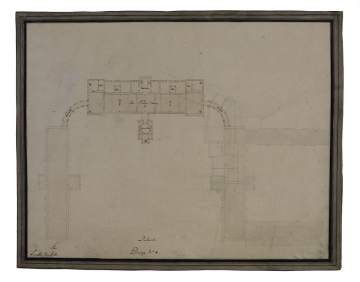
Browse
Reference number
Purpose
Aspect
Inscribed
Signed and dated
- (Soane) Lincolns Inn Field and datable to May 1811
Medium and dimensions
Hand
Watermark
Notes
The pencil revisions on SM 65/4/42 have been realised in these plans. The Gallery moves to the south west of the College, re-creating the quadrangular plan, open to the east. The Gallery is connected to the College by arcades and the Mausoleum remains on the east side of the Gallery.
There is a staircase drawn in the entrance porch of SM 64/4/39, which would presumably lead up to the Gallery still situated on the first floor of the two-storey range as seen in the preliminary plans. SM 65/4/40 is a further development of SM 64/4/39. The old women's almshouses and the Gallery are in the same single-storey range. The almshouses are situated along the length of the Gallery. This drawing is close to SM 65/4/41. However the Gallery is set further back towards the west and is connected to the north and south wings by a quadrant arcade.
Literature
G. Waterfield, Soane and after: the architecture of Dulwich Picture Gallery, 1987, pp. 31
C. Davies, 'Masters of building: the first independent purpose-built picture gallery: Dulwich Picture Gallery', Architect's Journal, April 1984, p. 59
Level
Sir John Soane's collection includes some 30,000 architectural, design and topographical drawings which is a very important resource for scholars worldwide. His was the first architect’s collection to attempt to preserve the best in design for the architectural profession in the future, and it did so by assembling as exemplars surviving drawings by great Renaissance masters and by the leading architects in Britain in the 17th and 18th centuries and his near contemporaries such as Sir William Chambers, Robert Adam and George Dance the Younger. These drawings sit side by side with 9,000 drawings in Soane’s own hand or those of the pupils in his office, covering his early work as a student, his time in Italy and the drawings produced in the course of his architectural practice from 1780 until the 1830s.
Browse (via the vertical menu to the left) and search results for Drawings include a mixture of Concise catalogue records – drawn from an outline list of the collection – and fuller records where drawings have been catalogued in more detail (an ongoing process).

